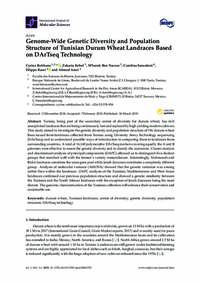Genome-Wide Genetic Diversity and Population Structure of Tunisian Durum Wheat Landraces Based on DArTseq Technology

Authors:
Tunisia, being part of the secondary center of diversity for durum wheat, has rich unexploited landraces that are being continuously lost and replaced by high yielding modern cultivars. This study aimed to investigate the genetic diversity and population structure of 196 durum wheat lines issued from landraces collected from Tunisia using Diversity Array Technology sequencing (DArTseq) and to understand possible ways of introduction in comparing them to landraces from surrounding countries. A total of 16,148 polymorphic DArTseq markers covering equally the A and B genomes were effective to assess the genetic diversity and to classify the accessions. Cluster analysis and discriminant analysis of principal components (DAPC) allowed us to distinguish five distinct groups that matched well with the farmer’s variety nomenclature. Interestingly, Mahmoudi and Biskri landraces constitute the same gene pool while Jenah Zarzoura constitutes a completely different group. Analysis of molecular variance (AMOVA) showed that the genetic variation was among rather than within the landraces. DAPC analysis of the Tunisian, Mediterranean and West Asian landraces confirmed our previous population structure and showed a genetic similarity between the Tunisian and the North African landraces with the exception of Jenah Zarzoura being the most distant. The genomic characterization of the Tunisian collection will enhance their conservation and sustainable use.
